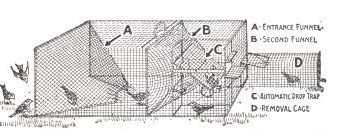How To Make A Sparrow Trap

A sparrow trap is an absolutely awesome trap to have when you are living off the land. Primarily used today to capture sparrows doing damage to a home garden, but in the not too distant future it will be a great way to capture food.
A sparrow trap can be made of many different types of materials. Metal wire mesh traps are common today and work great because they will last a very long time and will take a fair amount of abuse. However, traditionally they were made of wood. You can use wood or string or plastic or metal etc. Just use whatever you have and improvise.
The principle is what is important and variations vary greatly. Some traps use funnels that only allow easy movement through the opening in one direction. Others use doors that open and close depending on the weight of the bird to open and close the door.
Basically all of the traps have multiple compartments. The first compartment is where the bird will enter the trap initially. The bird will continue on to the next compartment where the food is located that lured the bird inside in the first place. Some will have a fourth compartment that is used to isolate a single bird so that it can be easily removed without allowing the other birds any means of escape.
How each design varies is the method that they use to separate the first and second compartments from each other. One method pictured above uses a simple funnel that has prongs that extend inward. The bird encounters a little resistance upon entering but the point of the prongs point inward so there is no harm to the bird. However, if the bird tries to exit the same way it entered then the pointy ends of the prongs will poke the bird and prevent the bird from using that opening.
Another type of door that is used is a weight activated door. I prefer these because although they sound more complicated they are actually easier to fine tune and get working properly than the simple funnel opening. The weight activated door uses the weight of the bird to open the entrance to the second chamber and at the same time close off the entrance to the first chamber.
This design is different in that the first chamber only has room to hold one bird. How it work! The bird approaches the trap and wants to get at the seed provided as bait. The trap has a chamber that the bird can see the seed and the bird looks for a way in. The only opening is simply a circular or square opening with no restrictions of any kind. The floor of the chamber is one end of a pivot. As the bird enters and puts its weight on the floor, the floor lowers which exposes the opening to the second chamber. The opening to the second chamber was below the floor and the bird's weight lowered the floor thereby exposing the opening. As the bird enters the second chamber the floor rises back up and this closes off any access the bird has to get back out.
